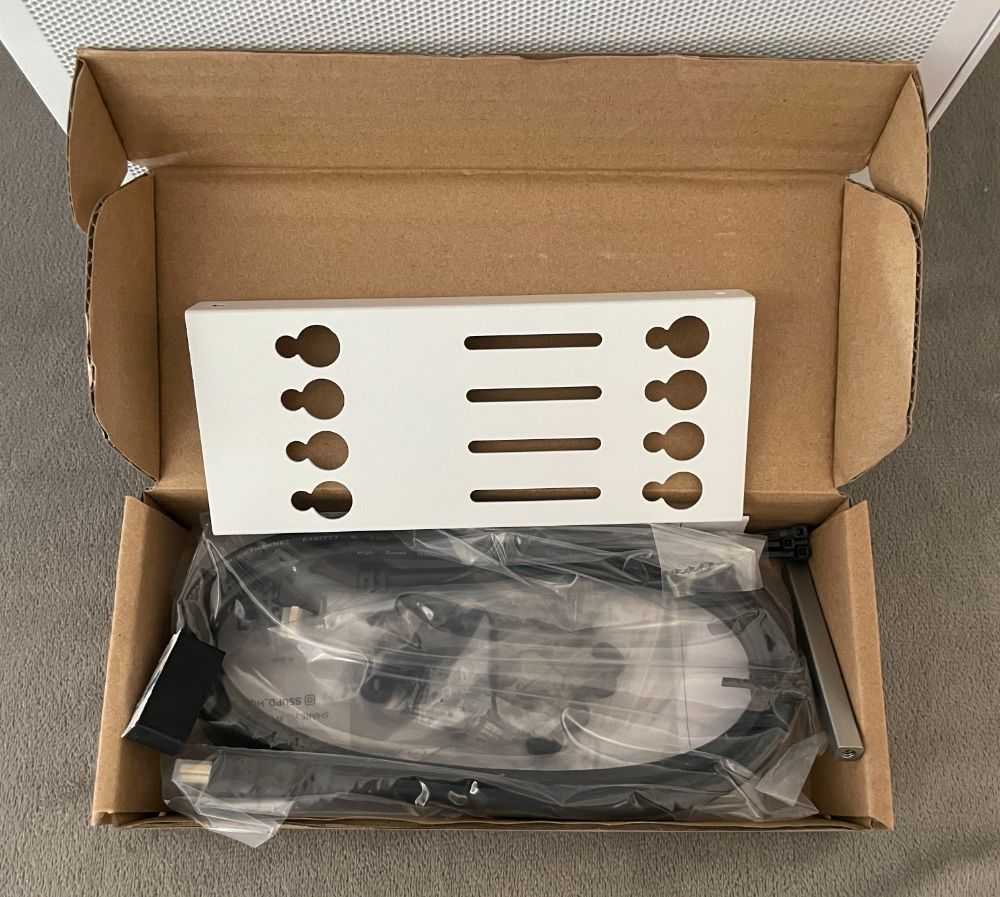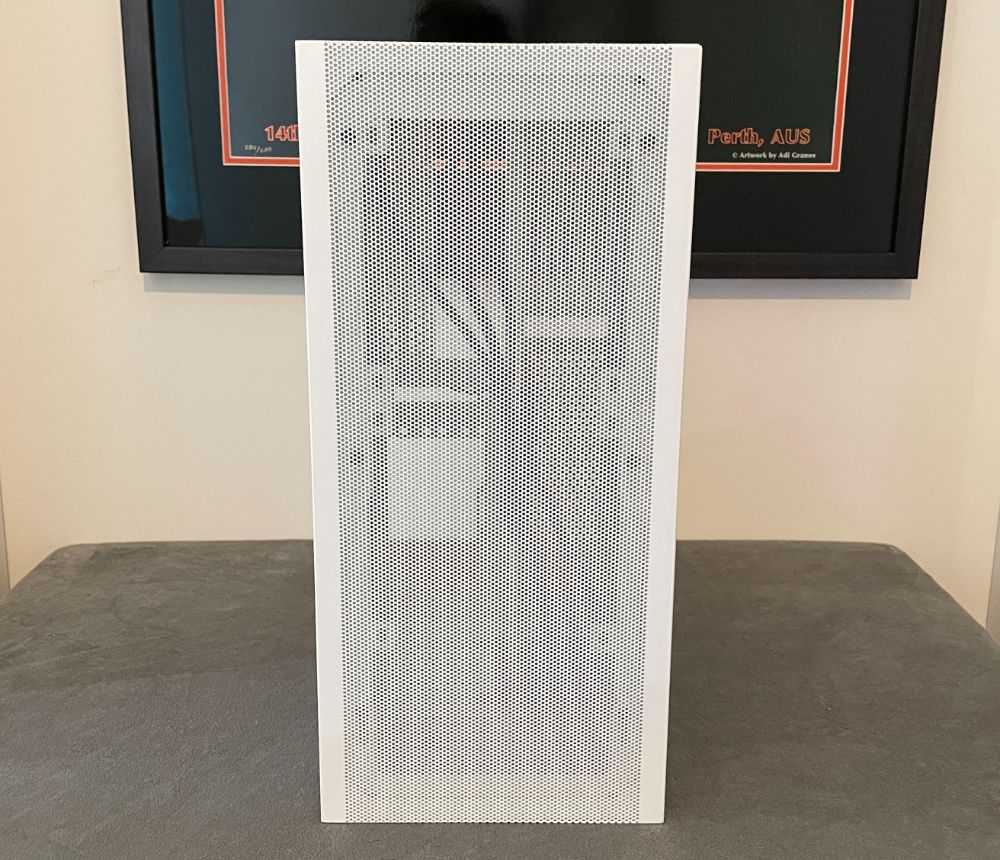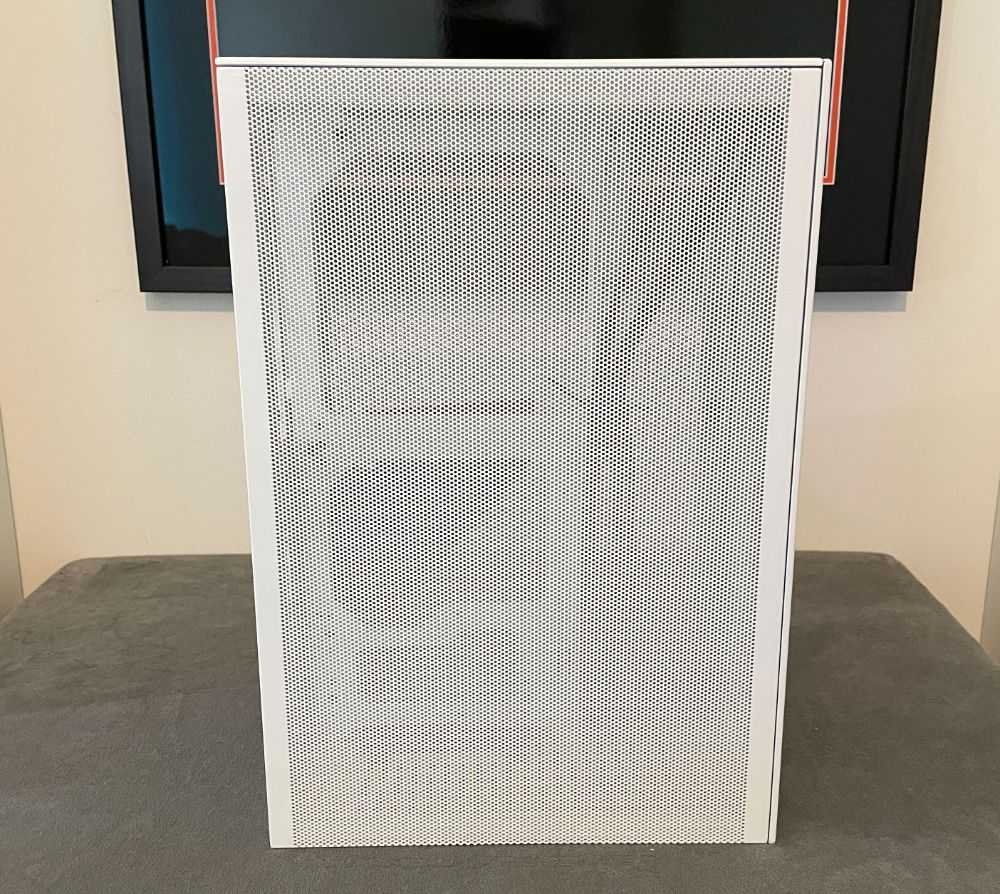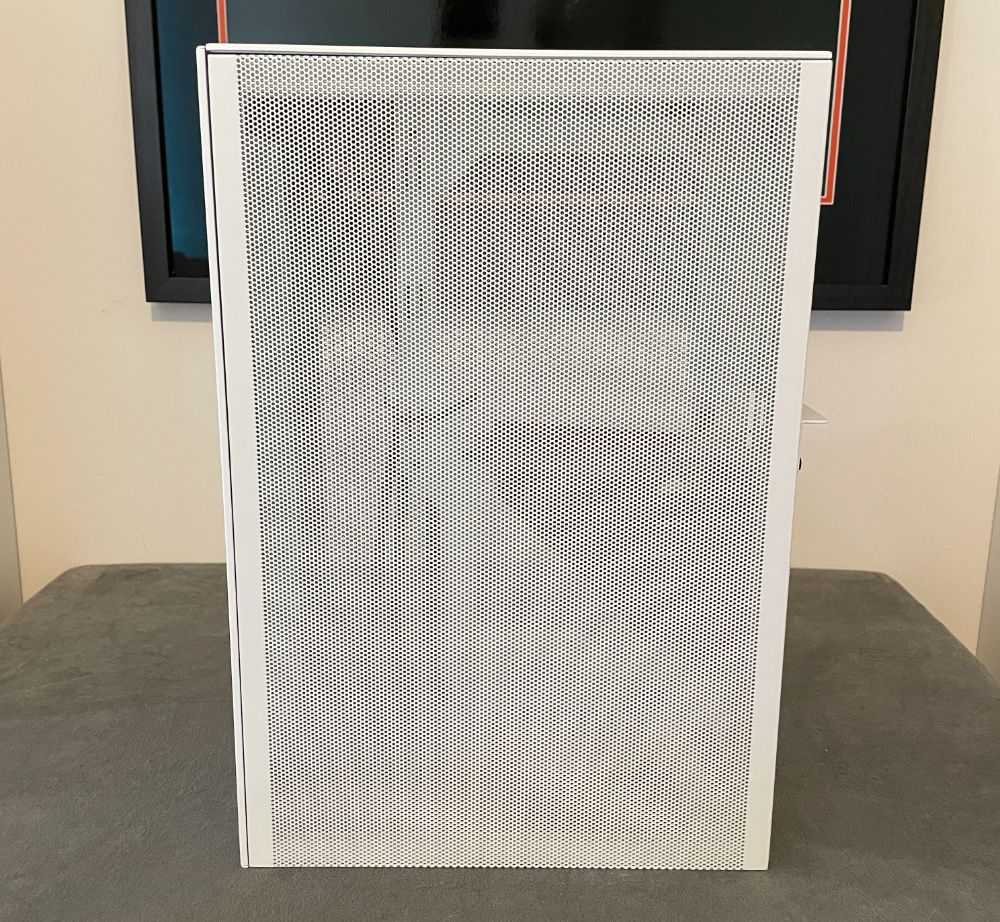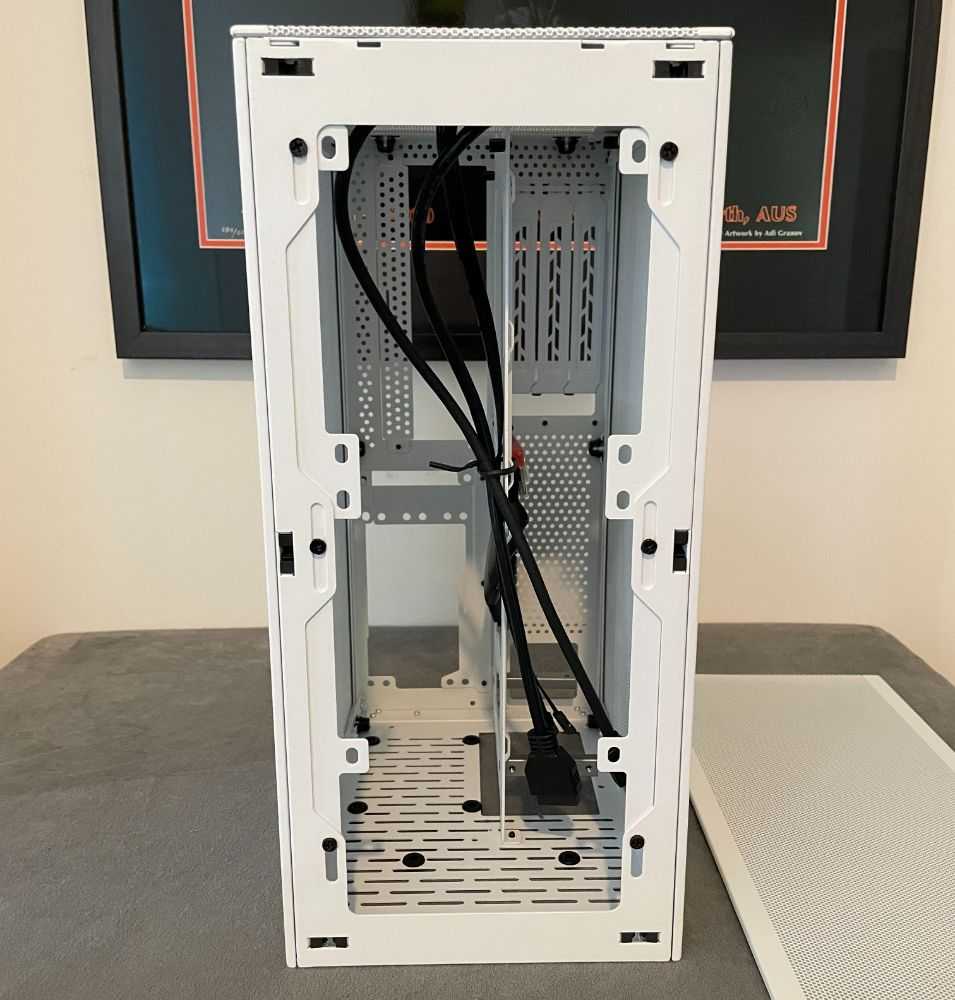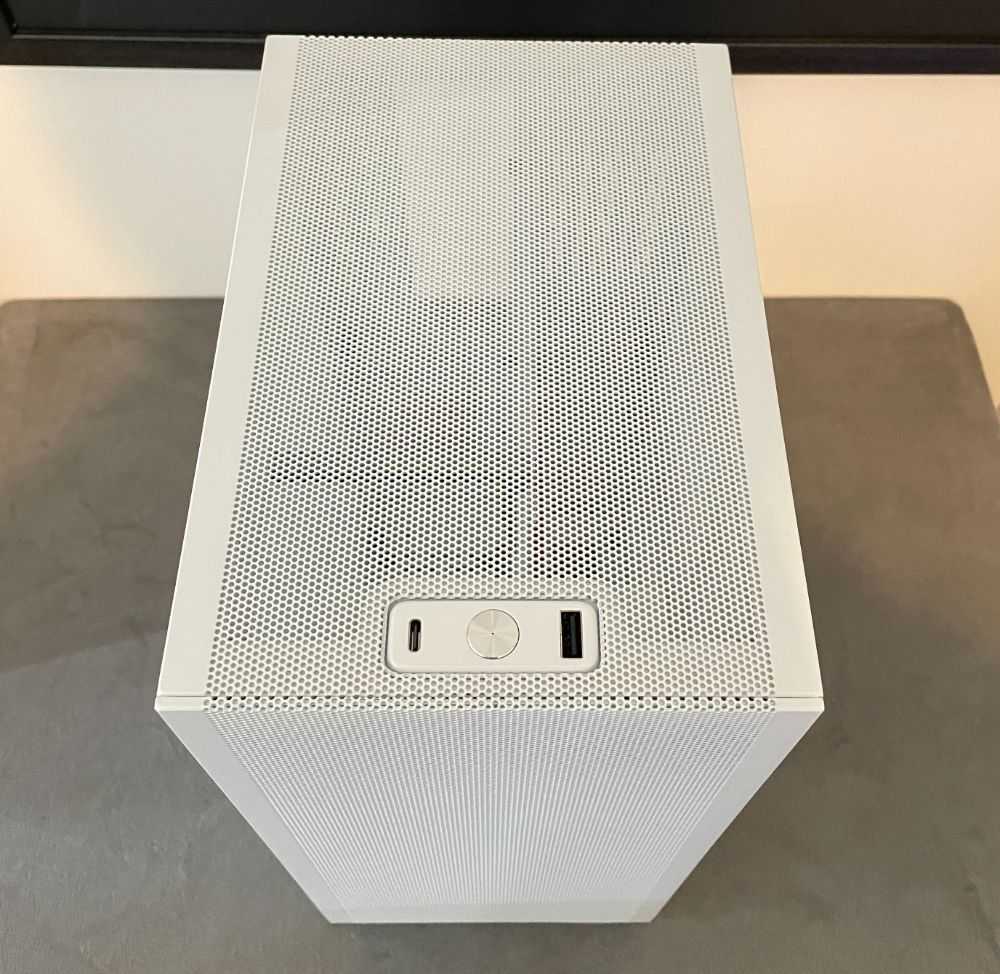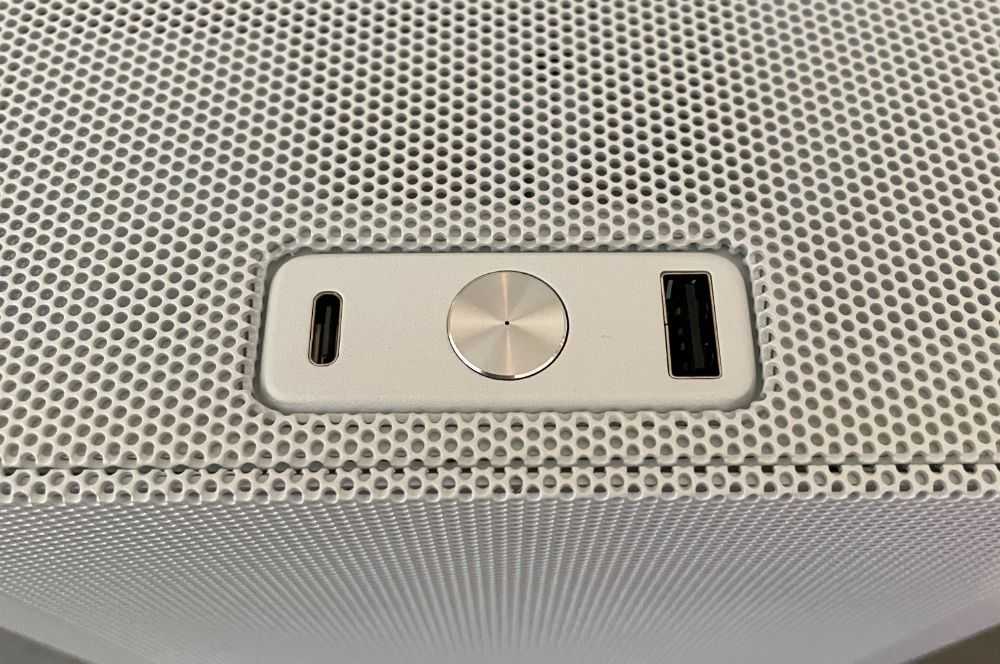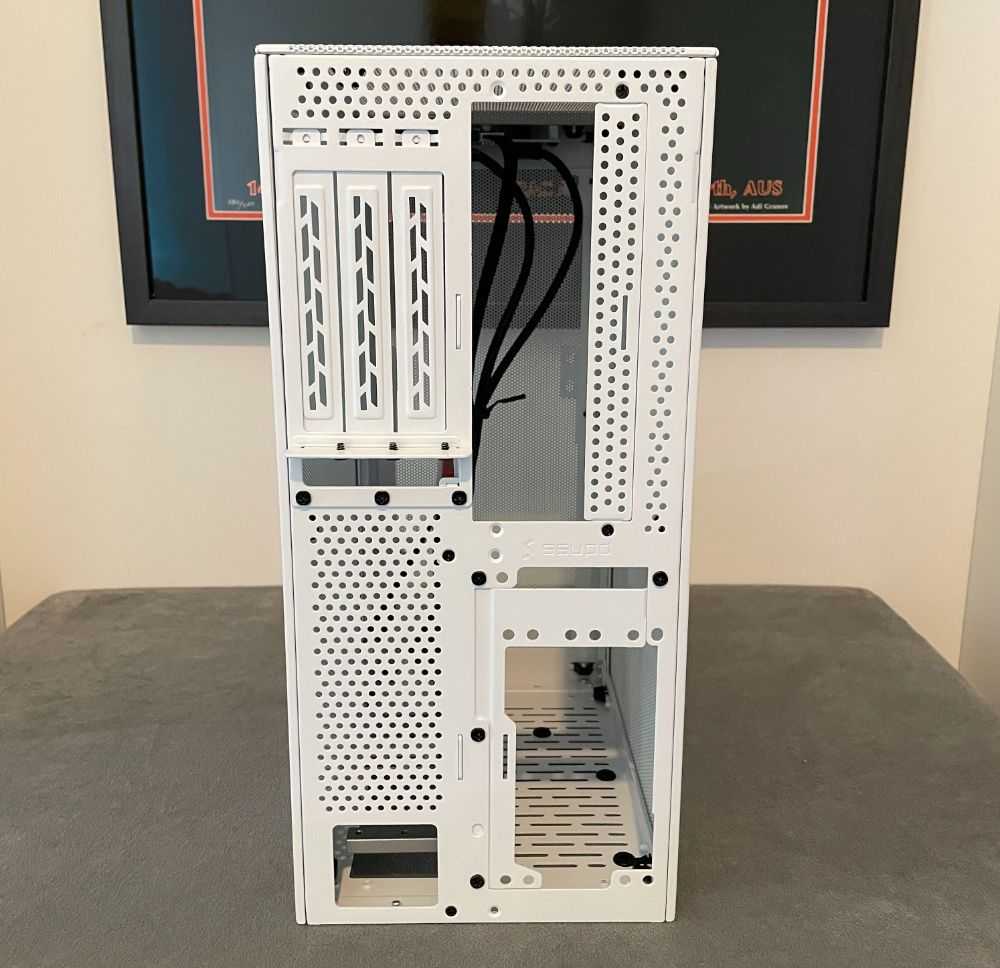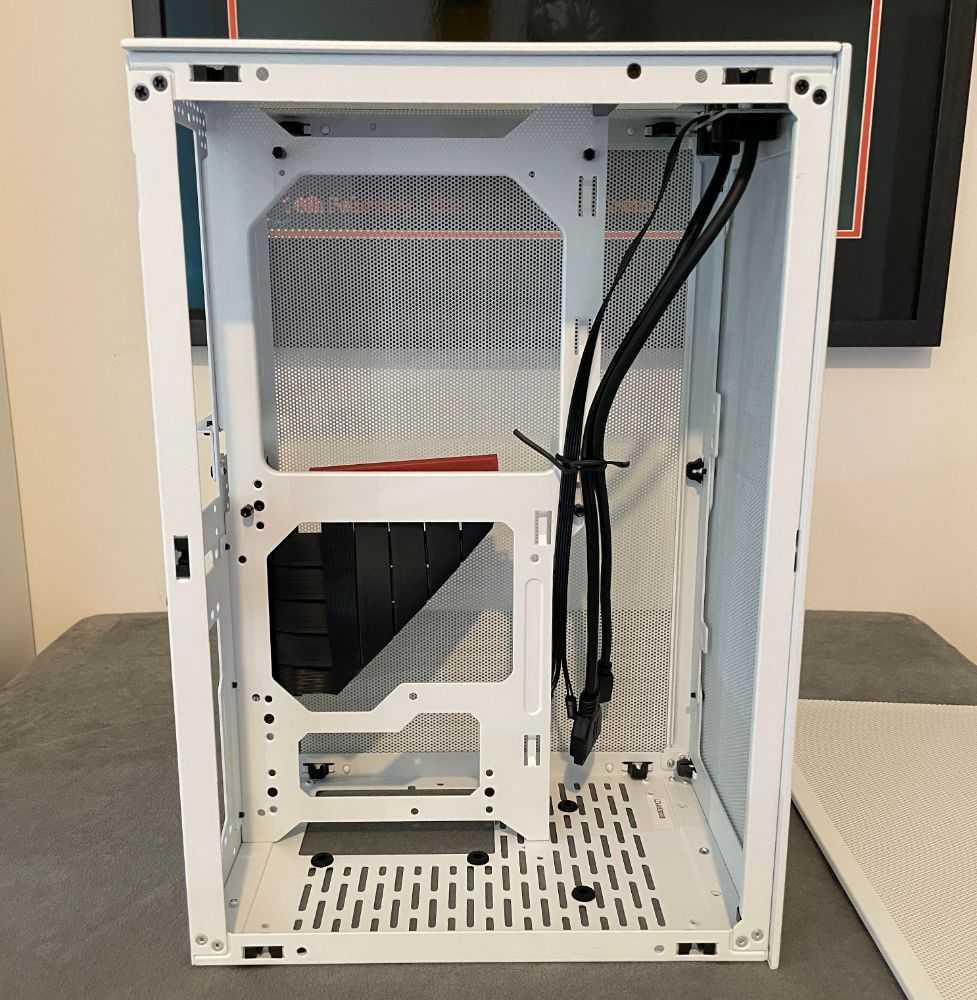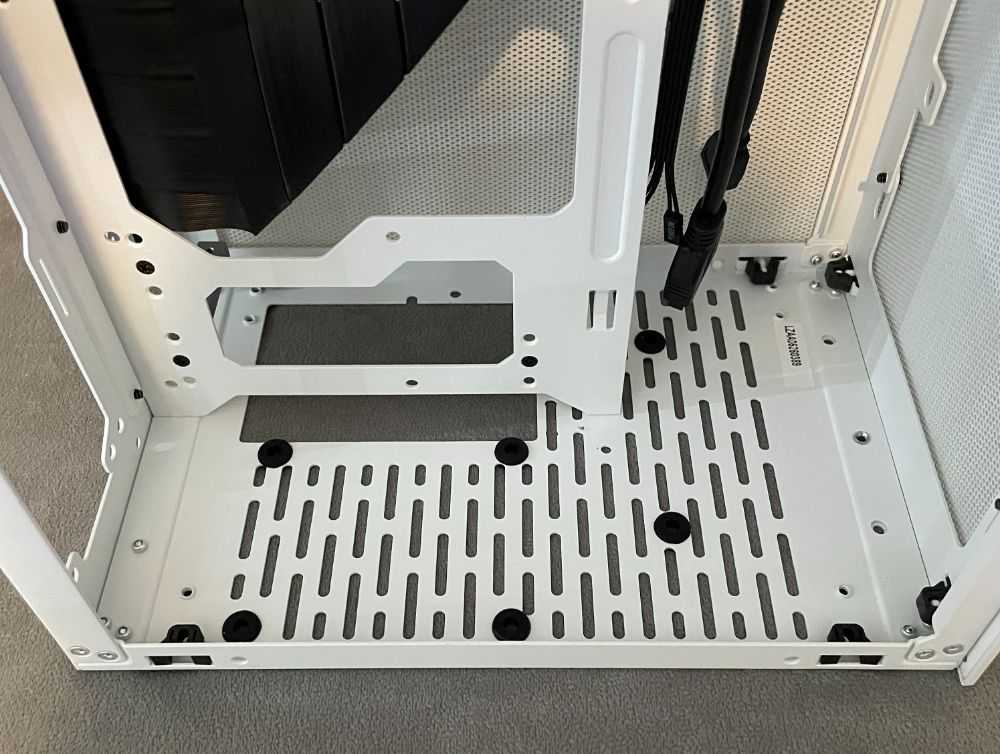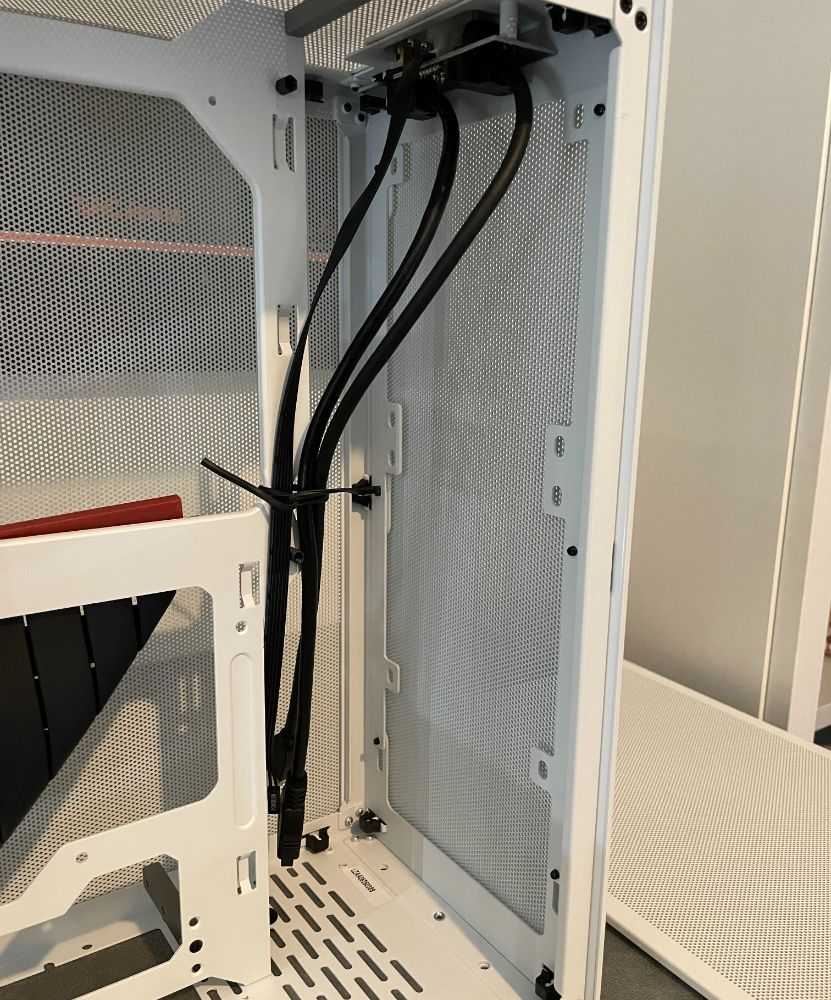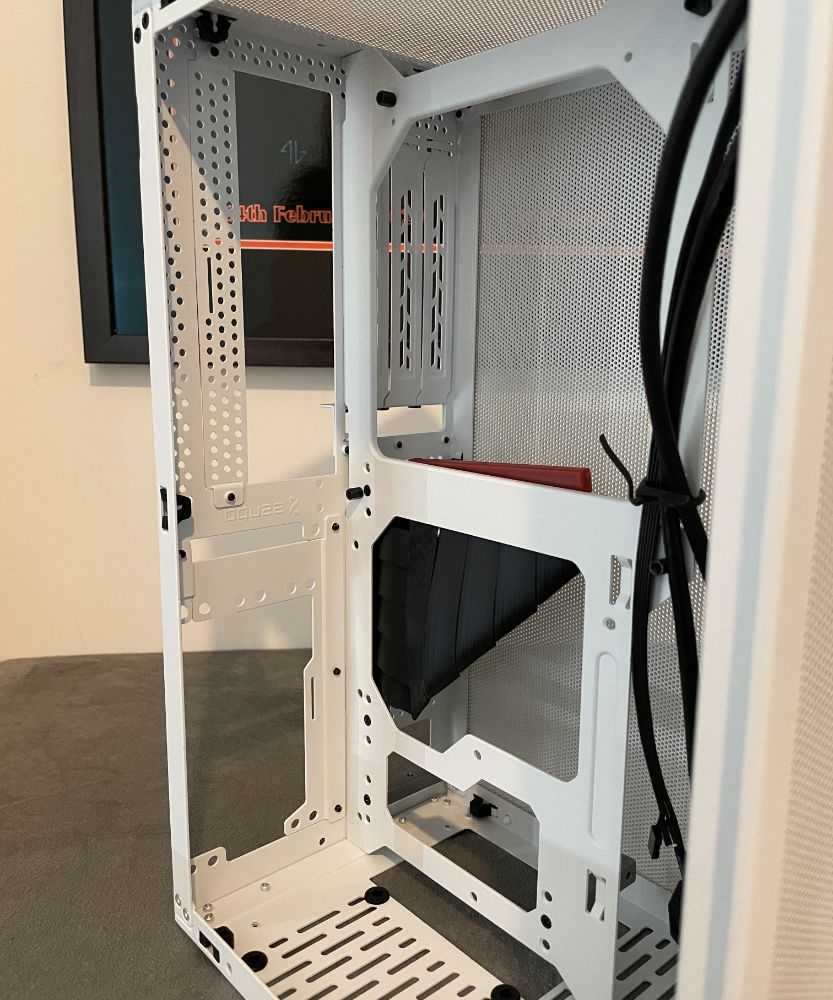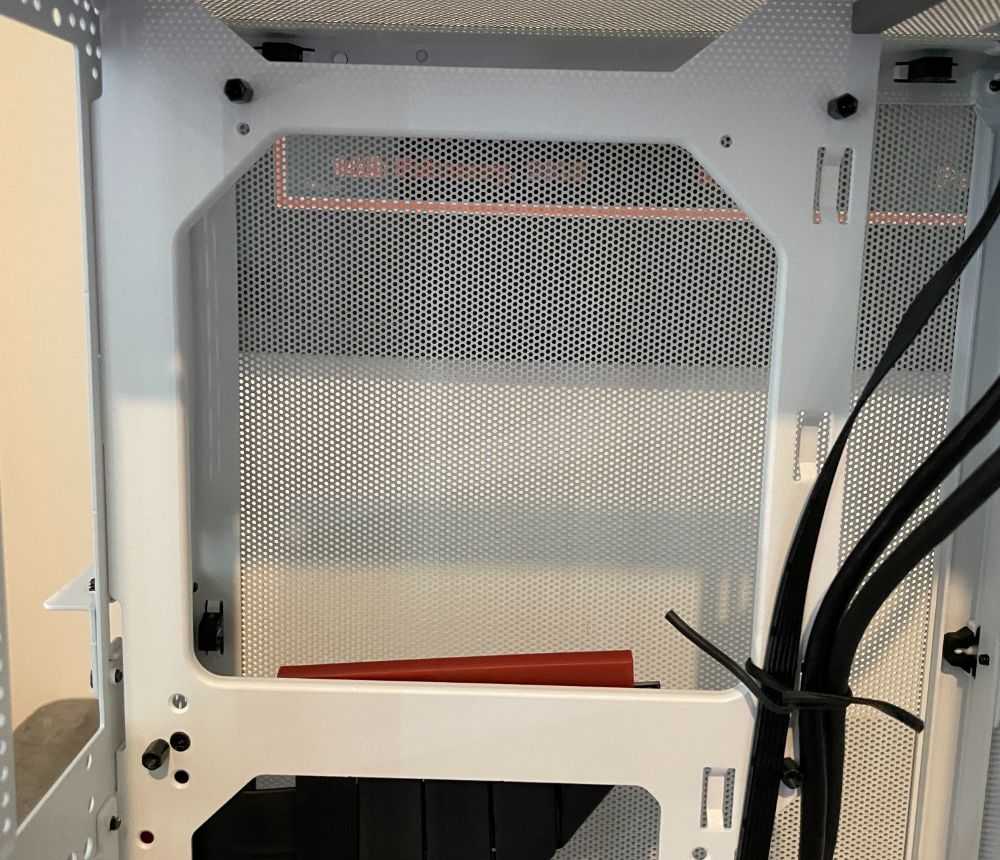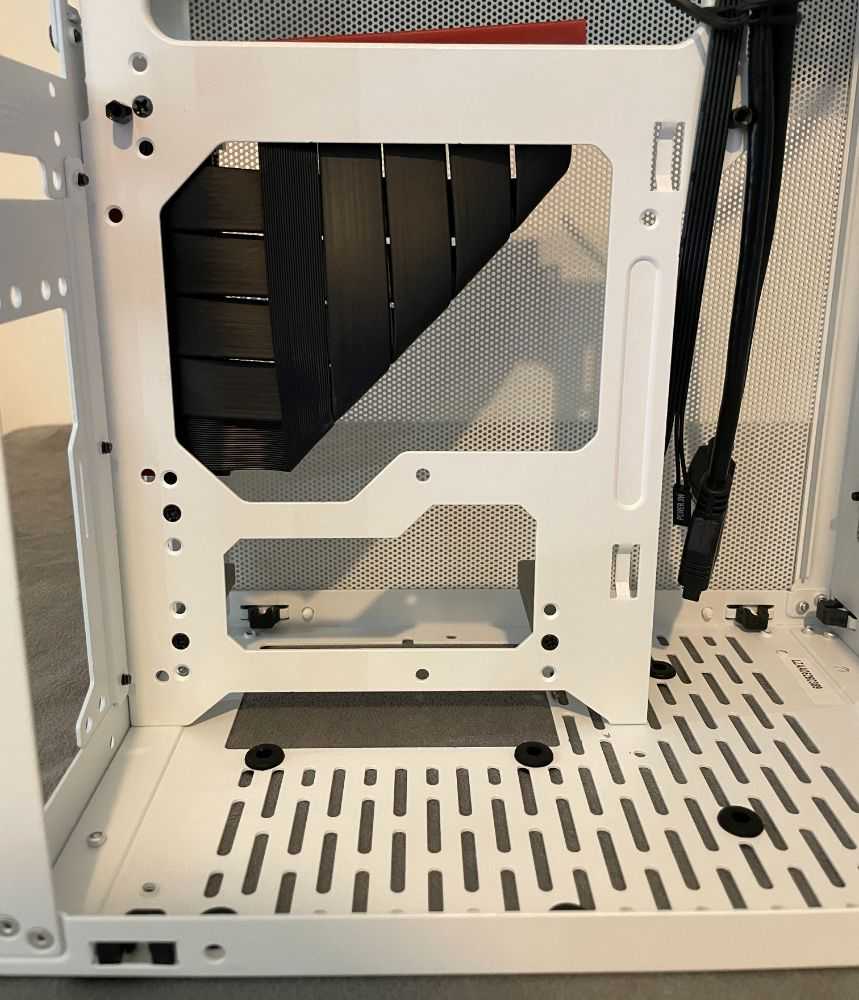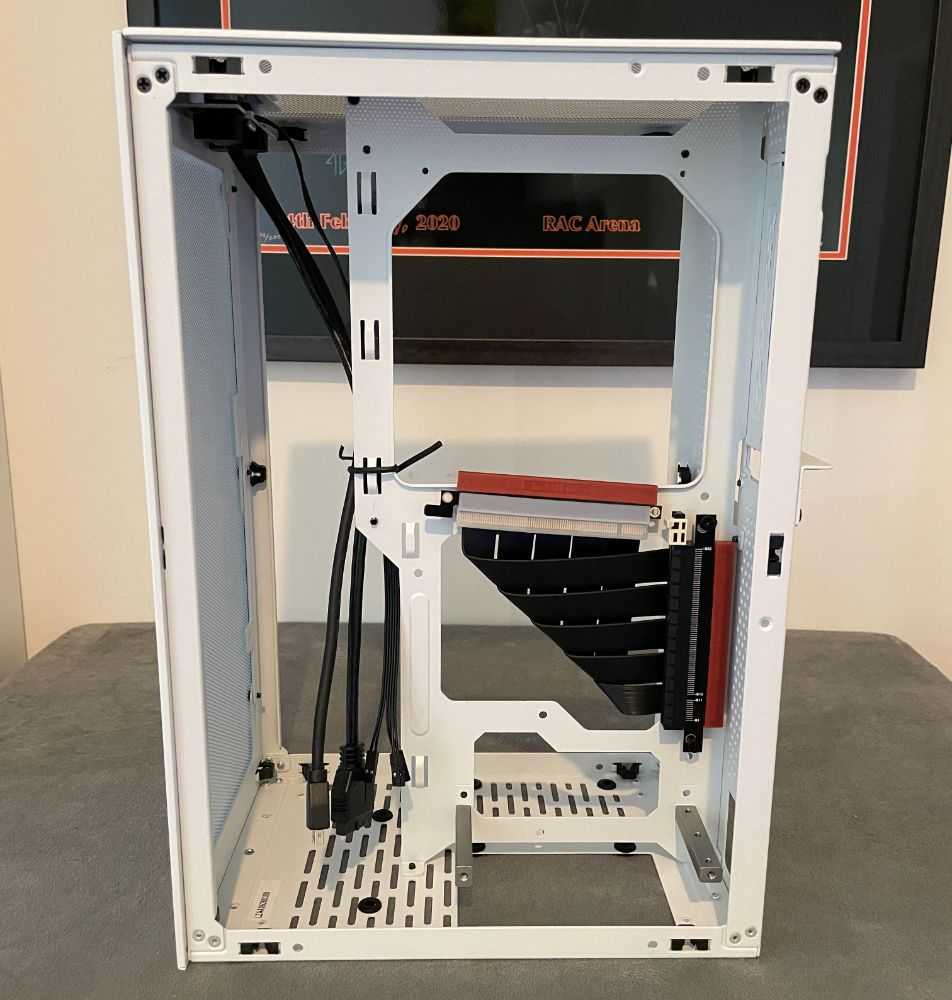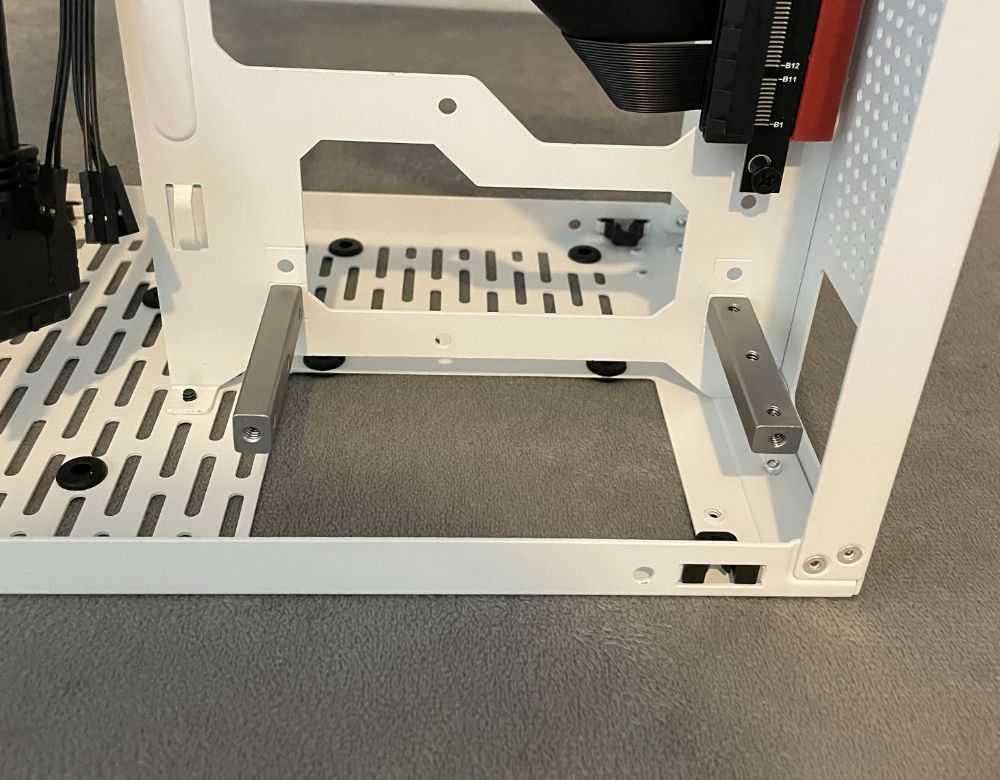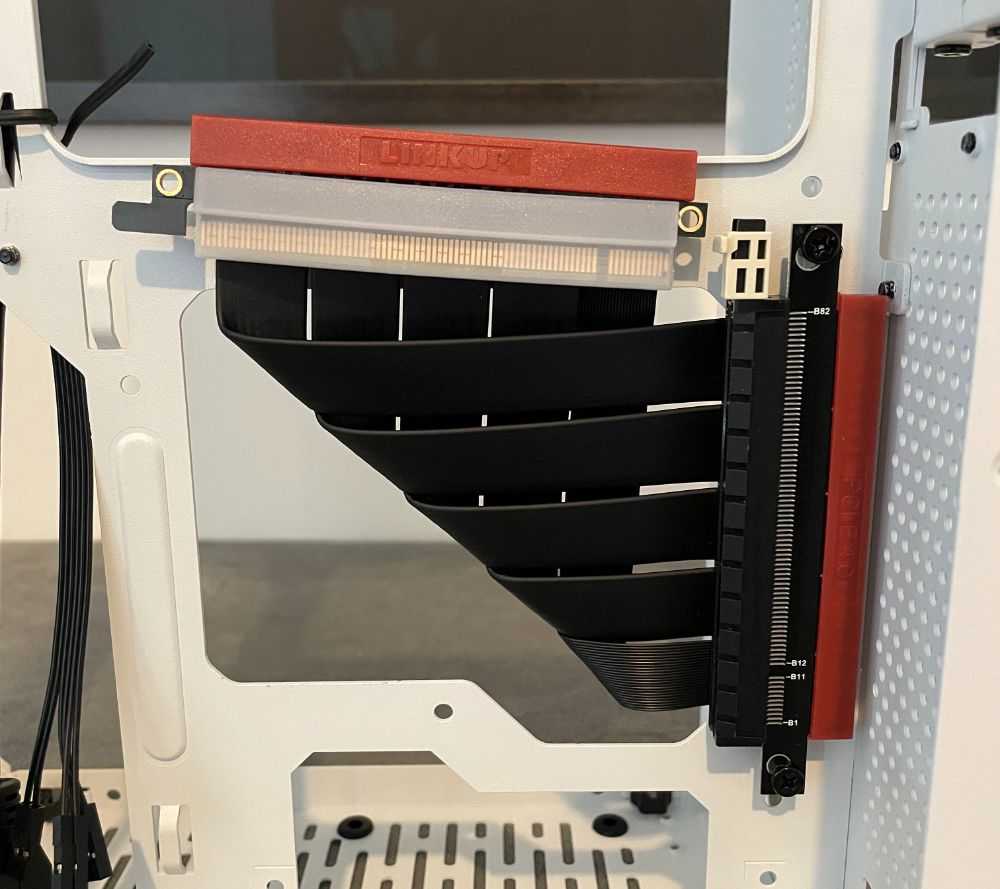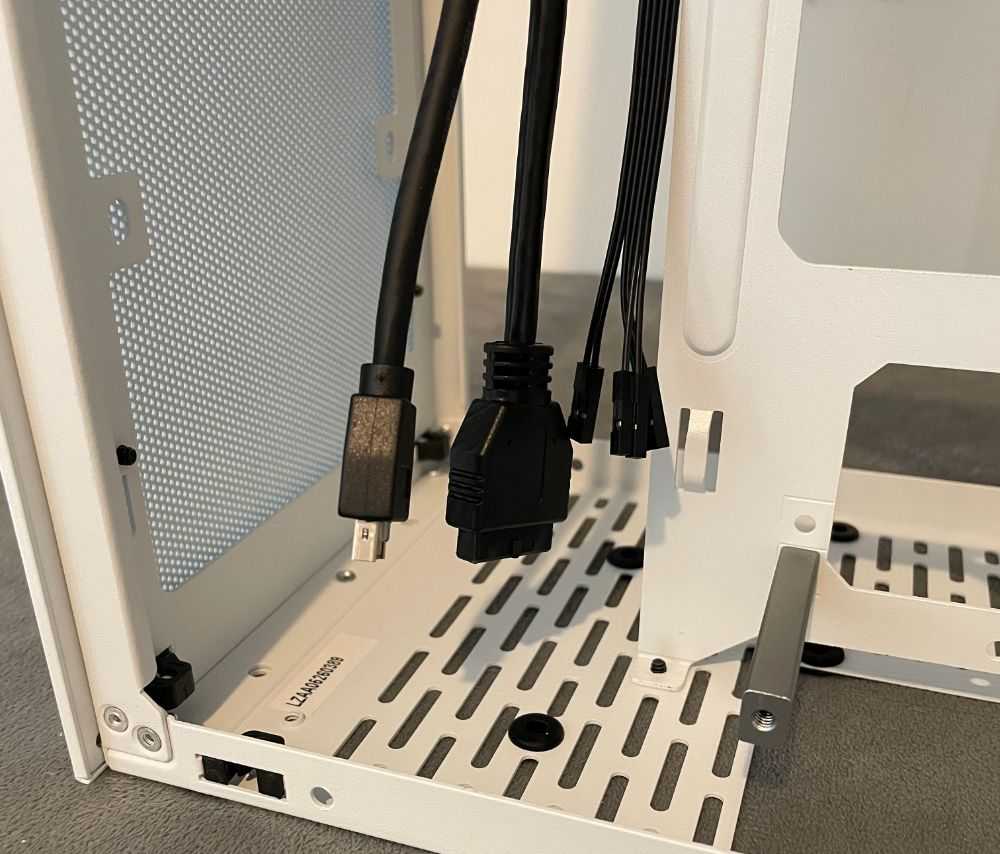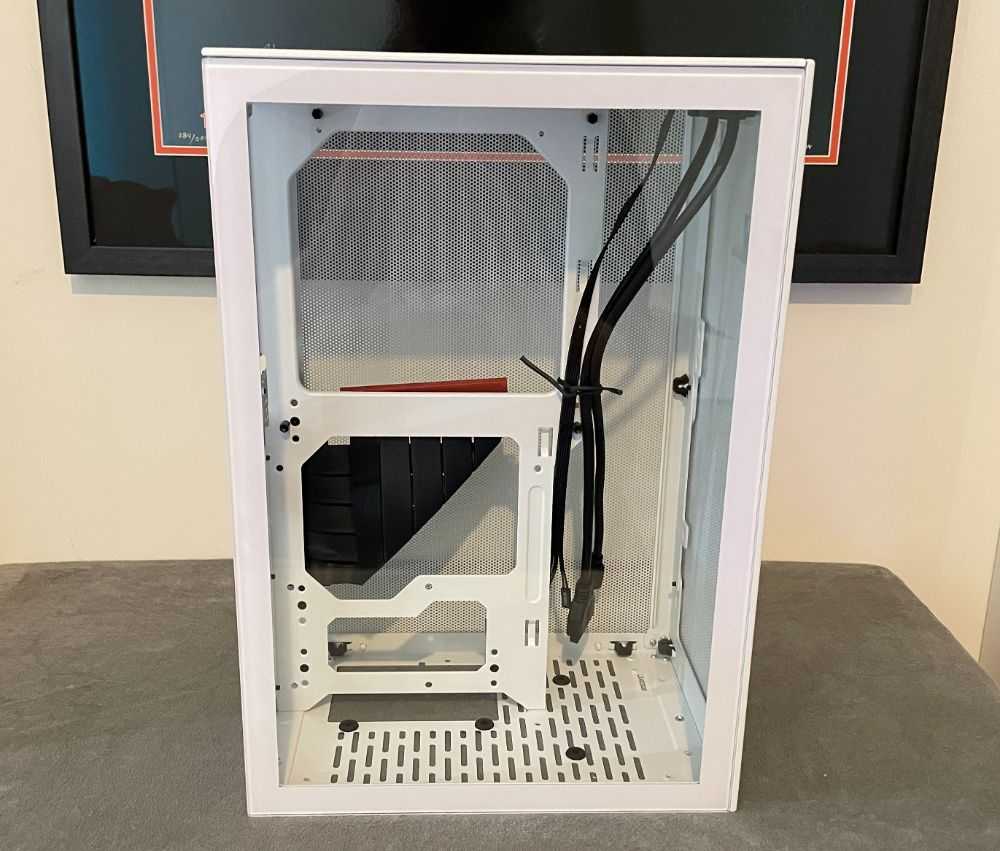How to Choose a Mini ITX Case
When you’re using a compact form-factor chassis, there are certain caveats that you need to be aware of. It’s nothing too complicated, but there’s certainly a learning curve involved if you’re a new builder. Routing is harder because of the limited space, and as most cables are pretty stiff, you need to plan ahead and get a case that’s comfortable to work with.
Cooling
OK. The main issue with cooling is that a lot of cases, as you can see, rely on passive negative pressure (air leaving your system). If you’re planning on running high-performing components, you need to invest in a product that doesn’t compromise on fan or radiator support.
If you’re interested in a high-end gaming rig, then make sure you can install at least two intake fans and an exhaust fan. This should be the basic setup of any air-cooled system. Adding more fans will only bring diminishing results, so as long as you cover the basic setup, you should be fine.
Additionally, adding radiators will limit the accepted length of your components. Take the thickness of the radiator and subtract it from the GPU length and you’ll find out what the updated hardware limitations are.
Parts Compatibility
Some mini-ITX cases do fit full-sized components, but some don’t. Based on the limitations, you’ll have to source ITX form-factor CPU coolers and GPUs. You will notice a significant drop in performance when working with a smaller GPU, even if, on paper, it has the same specifications as its full-sized variant.
Overall, all case manufacturers specify the maximum length or height of the components, so it’s very easy to pick compatible hardware. Just note that some cases provide better hardware support than others without sacrificing a lot of space.
Storage Options
Innate storage support is also a big topic when building in a Mini-ITX case. Sure, it helps if you can install an nVME SSD on your board, but you also need bulk storage for your PC games, work-related files, media, and more. So, if storage is a big factor for you, then the case with the most drive bays is definitely the way to go. There are plenty of cases with flexible storage options, so just browse ‘till you find one that meets your needs.
Noise
If you’re going with full air cooling, noise becomes an issue when running high-end hardware. That’s why you need to get a case with industrial sound-dampened steel panels and, why not, sound dampening pads, as we’ve seen with some cases. Picking up silent-branded case fans will also help with noise.
Cable Management and Routing
Oof. Big oof. Cable management is a real drag when building in a small form-factor chassis. That’s why we highly recommend that you go with a fully-modular PSU to make things easier. A lot of manufacturers choose to limit cable management options to keep manufacturing costs down and to keep dimensions as small as possible. Having a PSU cage, rubberized grommets, and a roomy back cage, these are all indicators that the case is optimized for cable management.
Overall, if you’re running an APU or a low-profile GPU, cable management isn’t crucial. While it will further limit the airflow and will increase dust build-up over time, the negative impact will be minimal.
SSUPD Meshlicious Mini-ITX Case Packaging
A lot of people consider the product’s packaging and its contents important. So, we’re including these in our SSUPD Meshlicious Mini-ITX Case review too.
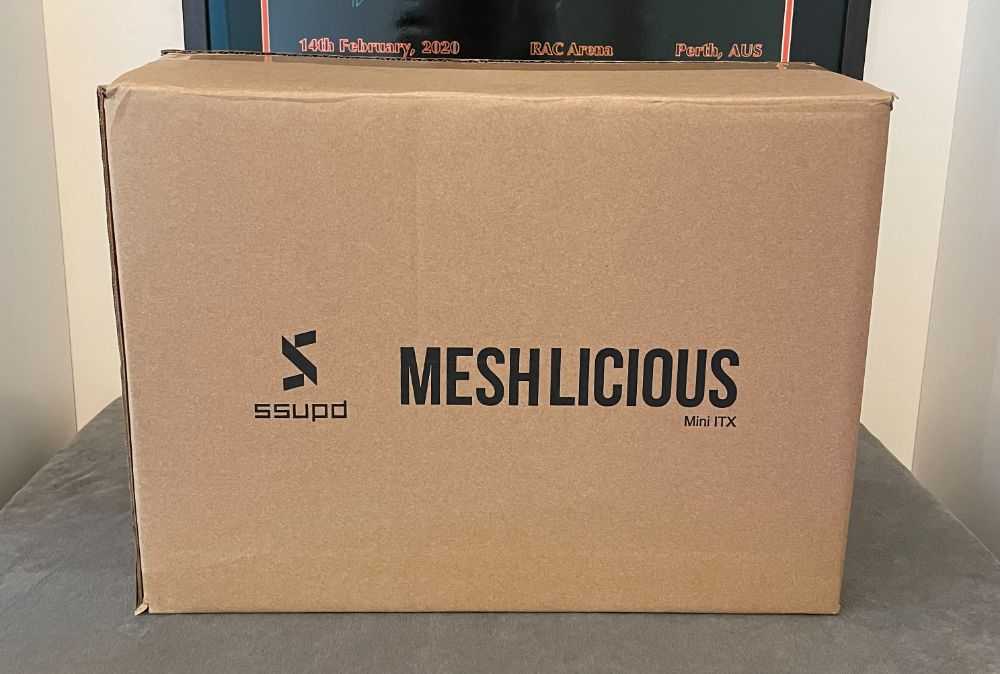
To begin, our white Meshlicious Mini-ITX Case arrived in a simple brown cardboard box with its name on it. Other than that, there’s nothing else of interest to see on the box.
Inside, you’ll find two foam spacers that hold the case in place. There’s also a plastic bag covering the product for added protection against fingerprints and scratches.
You’ll get a couple of unique parts together with the case for the two primary ways of setup. One will focus on the storage with a shorter GPU, while the other on a longer GPU. The latter can be up to four slots thick.
To help build your system, SSUPD included a detailed manual inside the package. They also included HDMI cables and a PCIe 3.0 ribbon cable for a horizontal GPU setup.
Performance Testing
As I had never reviewed an ITX case before, and didn’t have a pre-existing test system for such an occasion, I took measurements with the equipment I used on an open bench, then inside the Meshlicious. Inside the case, I configured the two 120mm fans for the AIO as intakes, and placed the mesh panel on the graphics card side of the enclosure.
Specification of Test System:
- AMD Ryzen 5 3600X
- ASRock B550M-ITX
- 16 GB (2×8) GSkill Trident Z 3333 (Overclocked to 3600 MHz)
- Zotac Amp Extreme GTX 1080ti with Arctic Cooling Accelero Extreme III (Fans locked at 50%)
- Sabrent Rocket NVMe 4.0 500GB
- Cooler Master ML240 V2 All in One CPU cooler (fans locked at 100%)
Test Conditions:
- CPU Temperature Testing: OCCT set to Small FFTs for 30 minutes
- GPU Temperature Testing: Unigine Heaven set to Extreme at 1080p for 30 minutes.
- Ambient temperature was set to and monitored at 23℃
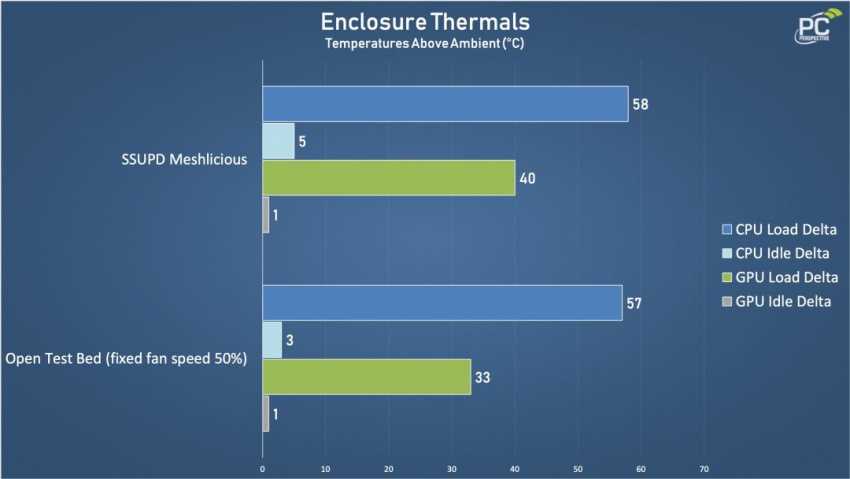
Using an AIO cooler for the CPU in the Meshlicious yields amazing results. The maximum CPU load temps were only 1℃ warmer, which is really within margin of error. The GPU temperatures were not quite as amazing, but still satisfactory. They were 7℃ warmer than on the open bench, but this is still an air-cooled, factory overclocked GTX 1080 Ti getting max temperatures of only 40℃ over ambient (63℃ total). No matter how you look at it, that’s still extremely good, especially considering that it was shoehorned into this sub-15 liter case.
Hands-on with the SSUPD Meshlicious Mini-ITX Case
The performance of this case is one of the most vital aspects of this SSUPD Meshlicious Mini-ITX Case review. Here, we’ll talk about how well it performed and if it’s something worth purchasing for your system.
But before anything else, let’s begin with how easy (or not) it was to build with the Meshlicious Mini-ITX Case.
To start building, we had to open the Meshlicious Mini-ITX case. Its four sides popped off quickly, making the first step an easy one. We didn’t need any tools to remove the four panels.
The frame of the chassis felt nice and sturdy even without the side panels.
Next, we installed the motherboard which was simple and all we had to do was screw it into place. The case supports two component layouts – a small form-factor graphics card mounted horizontally or a full-sized graphics card mounted vertically.
Using the former allows installing a drive rail system for 3.5 or 2.5” drives. Installing a vertically mounted longer GPU limits the drives that can be installed. Only two 2.5” drives can be installed at the case’s bottom.
Once we finished the building process, we noticed that the mesh design allowed for better airflow than in other cases.
Despite its size, it was easy to build a PC with the Meshlicious Mini-ITX case. With its well-planned design, we think even newbies in PC building can work on this chassis with no troubles.
After having everything installed, we saw how tight everything was. However, the GPU area was still clear of the cables. Plus, we were able to adequately reach most of the areas around the motherboard without any issues.
Once done, we positioned the side panels back in place. It was an easy process just like when we took them off. Technically, the glass panel should be on the CPU side since this is how SSUPD shipped the product.
However, after consulting the company too, we also benchmarked the case with its glass panel along the GPU side.
Thing is, we were still able to view the GPU through the mesh on both the front and sides. And this is while the clear glass panel offered a good and clear view of the CPU section.
It means, any ARGB element your parts could have will still be clearly visible in this case. Overall, everything looked quite nice and appealing with the AIO installed too.
Of course, you can opt to switch panels around to display the CPU or GPU side with the glass panel. If you have the glass on the CPU side, you can clearly view all the hardware inside.
Now our build isn’t really the cleanest one around. But, if you’re someone who wants to go the extra mile with it, you’ll surely do a better job.
Yet even so, it’s still nice to see the system getting cooled with an AIO. And even with its metal mesh cover, you’ll still get to see the shine of the cooling system. That also goes for the RGB of your memory.
When it comes to the performance of the SSUPD Meshlicious Mini-ITX Case, we were able to yield amazing results. The mesh design of the case means that we were able to get plenty of airflow into the case to help keep components nice and cool.
We noticed we found little difference in temps when compared to our regular ATX builds, which is fantastic news because often ITX builds run much hotter due to the confined space.
Key Features of the SSUPD Meshlicious Mini-ITX Case
Our SSUPD Meshlicious Mini-ITX Case review will now focus on the product’s key features. Let’s see what makes this chassis stand out from other similar products on the market.
Compatible with Radiators Measuring up to 280mm
The Meshlicious Mini-ITX case is an excellent chassis for liquid cooling. It supports a lot of radiators, including those as large as 280mm.
Support for Large CPUs – up to Four Slots
The tray of the motherboard works as a divider, allowing you to split the space for the CPU and GPU. This makes it possible for the chassis to support GPUs with thickness of up to 4 slots.
The GPU bracket can be adjusted vertically, allowing you to adjust the space for the cables connected to the GPU.
Keeps Components Cool
The Meshlicious Mini-ITX case is a high-airflow chassis with a small form-factor. Its design keeps components’ temperature levels low. As a result, your system performs at its best.
Supports ATX and SFX Power Supply
The Meshlicious Mini-ITX makes shifting from an ATX build easy. Since it’s compatible with both ATX and SFX power supplies, you won’t have to buy a new PSU.
Storage Drive Support up to Two HDDs and Four SSDs
Although small, the Meshlicious Mini-ITX can support up to two 3.5” hard drives or four 2.5” solid-state drives. This will depend on the size of the GPU that you install.
The Meshlicious Case
To start off with, this is by far the smallest case I’ve ever built in, eclipsing some of the more miniscule M-ATX cases on the market like the Silverstone FT-03, or SG10, and the only other ITX case I’ve previously used, the Metallicgear Neo Mini. The Meshlicious comes in at 245mm L x 166.4mm W x 360mm H. That’s 9.64 x 6.55 x 14.17 in the units used by nations who have landed men on the moon (I’m aware that NASA and their contractors used predominantly metric, just go with the joke).
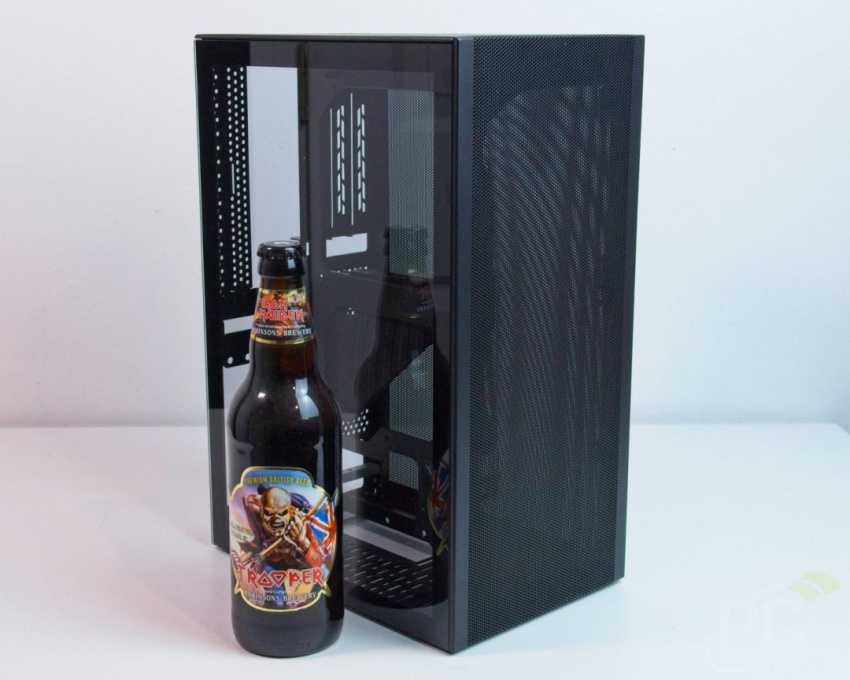
The internal volume of the Meshicious is 14.67 liters, and the footprint is an unbelievably small: 0.44 square feet. The front I/O consists of a power button with power and drive activity LEDs, one USB 3.1 type A, and one USB 3.2 Gen 2 Type C port.
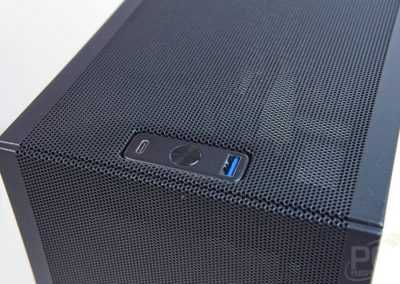
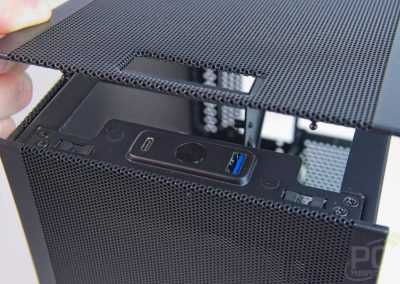
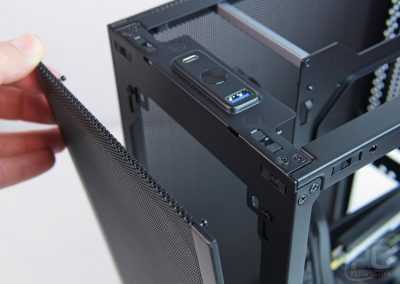
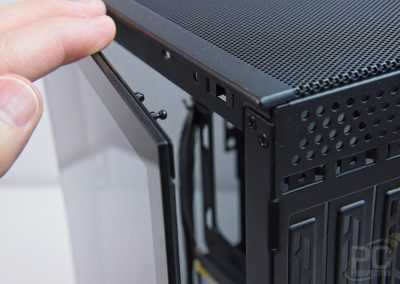
The front, top, and both side panels on the Meshlicious are easily removed. They’re held on by a pressure pin, and are completely tool less. When in place, the fit and finish of this chassis is absolutely top notch. The panels fit tightly together, with uniform seams and a high quality feel.
The bottom and rear of the chassis are not removable, but they are still designed for air flow, with plenty of ventilation slots cut into the steel. Depending on the options chosen at purchase, you can get either one mesh and one tempered glass side panel, or both mesh.
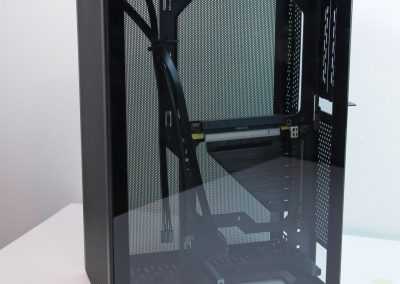
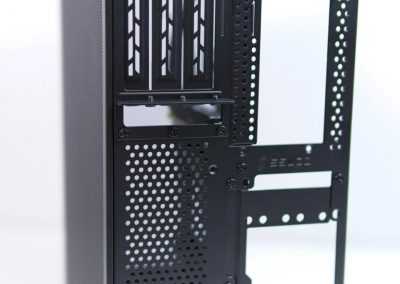
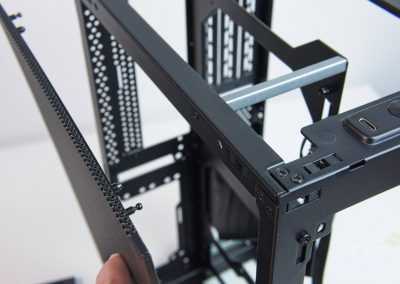
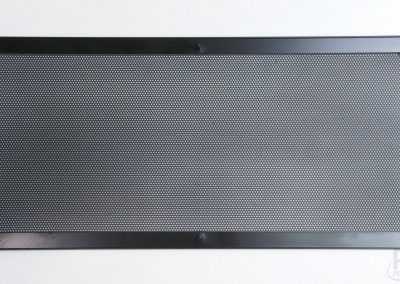
The Mesh pattern on the panels is actually fairly dense. They don’t flow as much as some of the more open metal mesh panels I’ve seen, but because of the density, they still offer very good airflow, and at least some level of dust filtration.
The all mesh panel version sells for $119 US, the mesh/tempered glass model is $109. Both are available in either black or white, and you can also choose a version that comes with a PCI-E gen 4 riser (instead of the Gen 3) for $60 more.
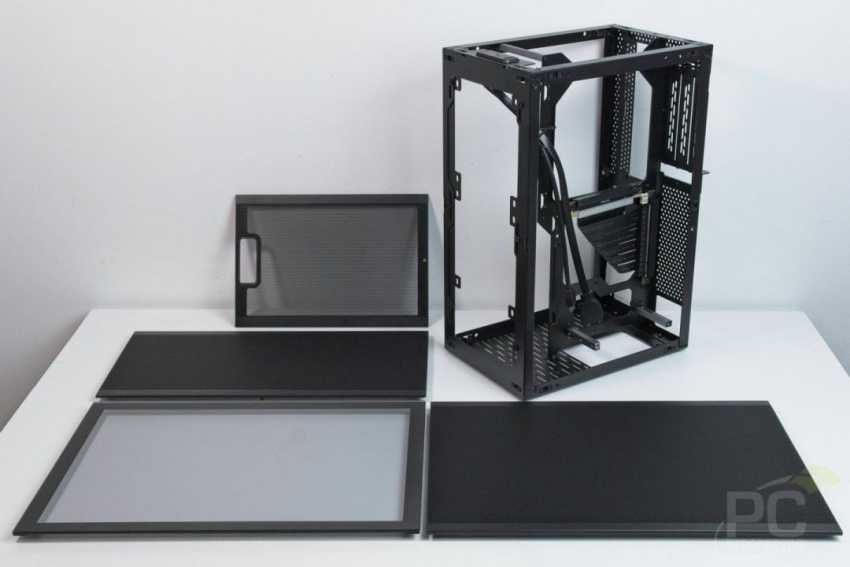
Regardless of the options you pick, with all the panels removed, the Meshlicious is so open, that in spite of its size, it becomes extremely easy to work in.
Лучший корпус Mini-ITX для геймеров
Corsair Graphite 380T (около 10 000 рублей)
Маленький корпус от Corsair станет хорошим выбором для геймеров, которые хотят совместить компактность исполнения, стильную подсветку и использование мощных полноразмерных графических карт. Corsair Graphite 380T предлагает все, что нужно и даже имеет встроенную ручку, которая делает его удобным для переноски. Внутрь можно даже установить небольшую СВО.
Интересная особенность Corsair Graphite 380T заключается в расположенном на корпусе конроллере для управления скоростью вращения вентилятора. Программное управление также предусмотрено. Все продумано на тот случай, если вам понадобится быстро усилить отвод воздуха из корпуса.
Изображения: компании-производители, HYPERPC
- Собираем настольный ПК: шаг 1 — выбираем корпус
- Выбираем компьютерный корпус: от мини-ПК до рабочей станции
- Лучшие корпуса для ПК необычной формы
Conclusion
After my experience with the SSUPD (Severus Snape Used Potions Deviously?) Meshlicious I have to say that I’m exceedingly impressed. Despite its size, the Meshlicious was both versatile and easy to build in, with many fewer hardware limitations than I’ve seen on many of its competitors.
Once built, the mesh, airflow focused, design performed better than many mid and full towers I’ve reviewed. I have to believe the all mesh version could do even better then my version with one tempered glass panel. Because of its well thought out design, I think even a novice PC builder could build in this chassis without trouble.
I’m very happy to recommend this case to anyone looking for a small footprint build, but not wanting to sacrifice performance. The SSUPD (OK, Sunny Side Up Designs) Meshlicious gets our Gold Award.
Meshlicious Build Notes
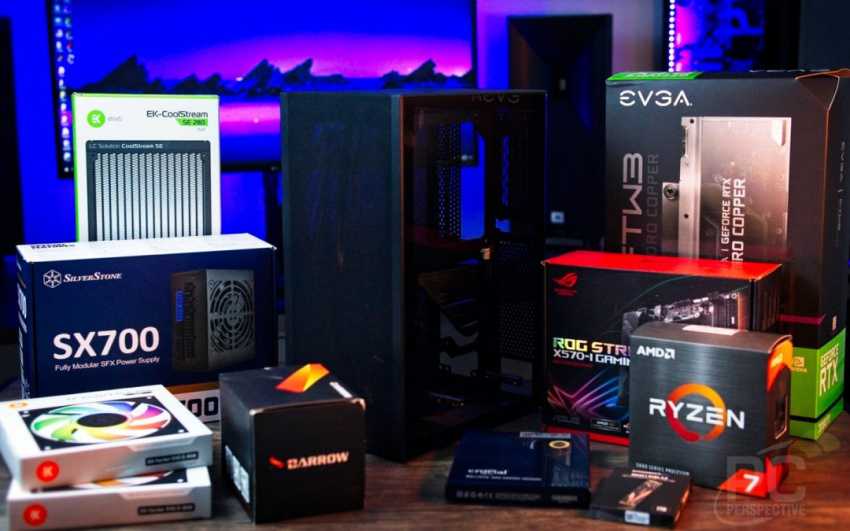
Ready for a mini-ITX build
The SSUPD (Sharon Stone’s Upskirt Paid Dividends?) Meshicious offers a few different configurations, depending on your choice in hardware. The motherboard tray can be shifted to allow for either a taller CPU cooler, or to allow for a thicker GPU (up to 4 slots). In the default motherboard tray location, there is even enough space to use an ATX power supply instead of having to use an SFX unit. You also have the option to use a short GPU, and add up to three 3.5” hard drives.
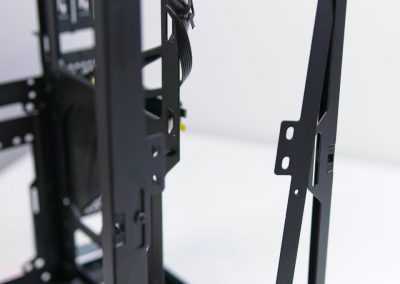
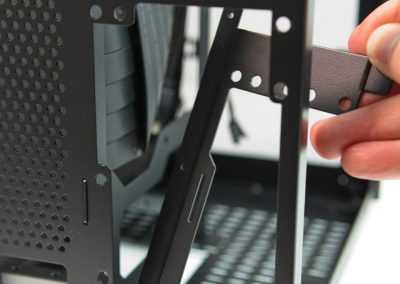
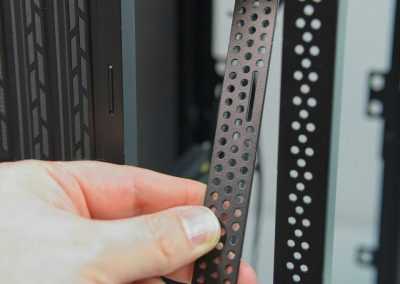
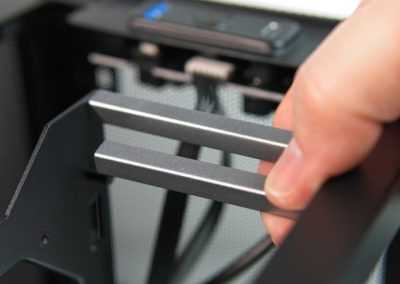
The drawback here is that the included PCI-E extension cable is not quite long enough, and you’d need to source another to make this work. With the included accessories, a new owner is essentially limited to the GPU vertically mounted behind the motherboard tray. The good news is that, unlike many of the sub 20 liter PC cases, I have yet to see a GPU that will not fit in this case. The GPU used (well over thirteen inches and exceeding three slots thickness) during testing this case fit with no issues.
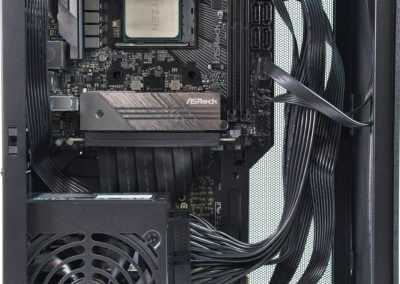
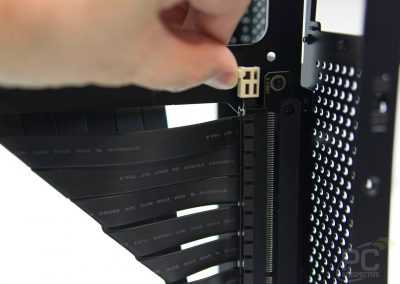
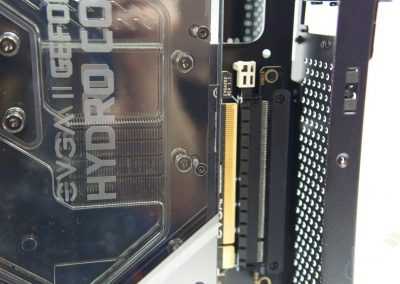
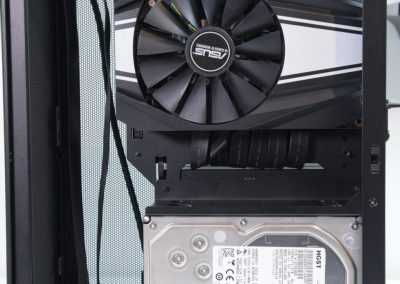
Speaking of the included PCI-E extension cable, I’ve seen some comments here and there showing concern over the durability and longevity of the cable, specifically because of the 45-degree fold in the ribbons. I tested several different layouts in the case, and removed and re-installed this cable a number of times with no ill effects to this point. Despite the fold in the cable, it doesn’t appear that any extra care would need to be taken with it, over the care one would show to any other PCI-E extension.
One of the great things about this case is that, despite its vertical orientation, the rear I/O of the motherboard and the GPU output do not exit the top of the tower. The rear I/O faces back, and the aforementioned Graphics output is at the bottom. I don’t think I’ve ever seen a vertical tower style case that utilizes space like this, and it really is an excellent design.
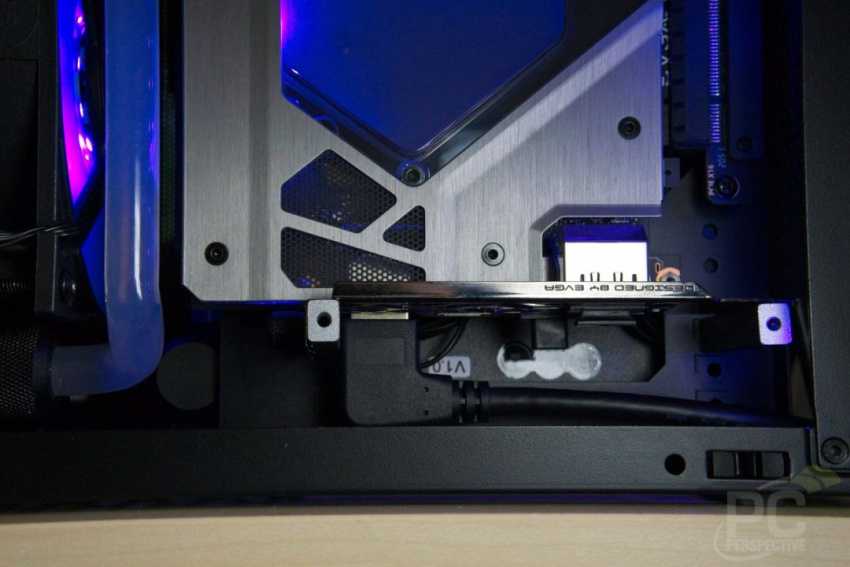
Due to the GPU layout which places the PCI-E bracket toward the bottom of the case, you will most likely need to use a display cable with a 90-degree angled connector. SSUPD (Super Speed Ultra Planar Driver?) does provide an angled HDMI cable, but disappointingly no angled DisplayPort cable.
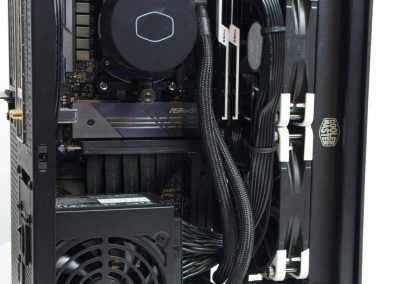
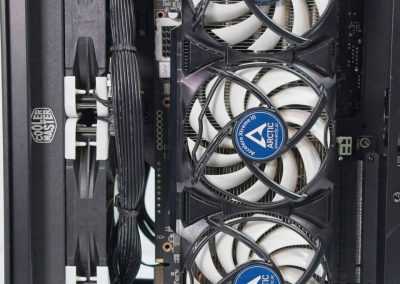
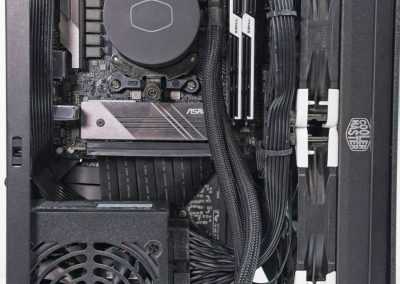
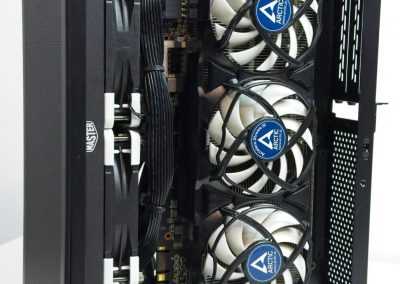
Unless you are going to some extra lengths to personalize your system (full closed loop hardline build, custom sleeved cables, or something along those lines) building a basic system with an AIO for the CPU cooling, and an air cooled GPU will be a relatively simple and pretty straightforward process. Depending on your goals, in most situations I would probably recommend going with the full mesh version of this tower, using a 240mm or 280mm AIO to cool your CPU, and positioning the fans as exhaust (pulling air in from the sides and pushing it out the front of the chassis). This would allow for better cooling of any components that don’t have active cooling.
My case arrived with one mesh and one tempered glass panel. In this circumstance, I would place the tempered glass over the CPU side and letting the GPU pull in its own air through the Mesh. I would also position the front fans as intakes. Using this method and an SFX power supply there is enough of a gap between the PSU fan and side panel that the PSU would not be starved for air.
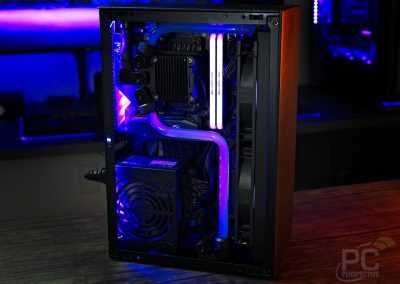
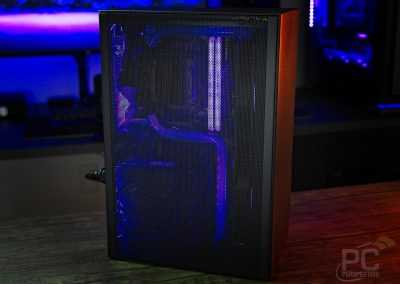
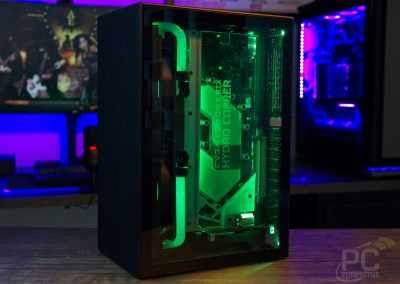

When building the closed loop system for the photos of the Meshlicious, I did a little experimentation with the included accessories and discovered that if I used the extra standoffs included, I could space the graphics card a little further from the motherboard tray, which allowed me to use that gap for better cable management. It actually turned out very well and the loop was much easier than I had initially anticipated. The biggest limitation I ran into was the overall width of the EVGA Hydro Copper block. Anyone using a standard height card, with a lower profile port connector would find the build even easier.
A 14.6 Liter Can of Whoop-Ass
In a world of PC Cases named such things as the Area 51 BR-459 Dynamic Mesh Air RGB, the SSUPD Meshlicious is an outlier. Reviewers and tech-tubers have been ranting for years about the naming schemes of products, and now we’ve gotten what we asked for: The Meshlicious. Aside from the naming scheme SSUPD apparently wanted to give us a lot more that we’ve been asking for:
- Under 15 liters: Check
- Unrestricted air flow: Check
- Support for full size graphics cards: Check
- Easy to build in: Check
Let’s get back to the name, SSUPD Meshlicious. According to the SSUPD website, Ssu was a lead designer with Lian Li for over 10 years, but has now split off and founded this sister brand; SSUPD, which stands for Sunny Side Up Designs.
I think we can come up with some better acronyms as we go (Sebastian Sets Up Podcasts Delinquently?). As the immortal bard once penned “what is in a name? A rose by any other name would still smell as sweet.” So is the SSUPD (Steven Seagal Unwittingly Punched DeNiro?) Meshlicious a rose by another name? Continue reading to find out.
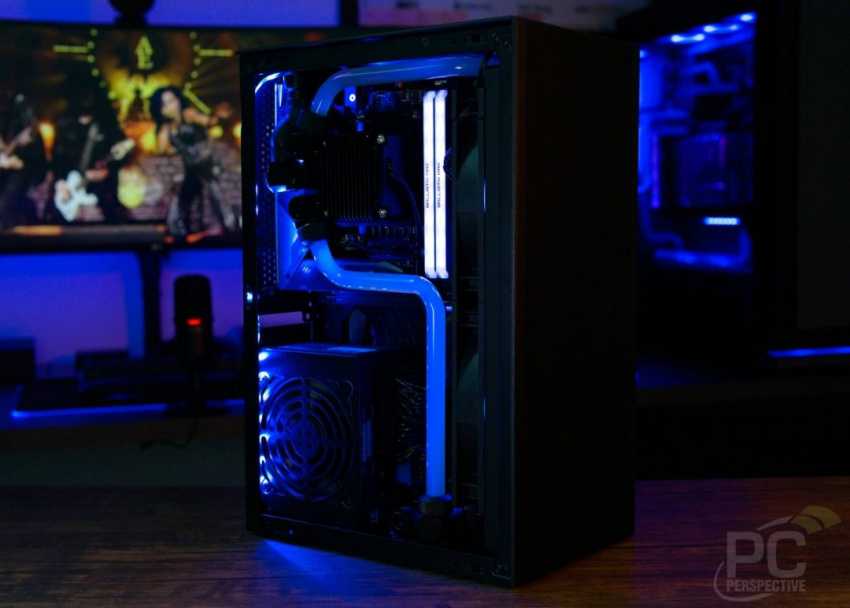
Product Specifications
- Motherboard compatibility: Mini ITX / Mini-DTX (need additional 20cm PCIe riser cable)
- Power supply type: ATX, SFX-L, SFX
- Expansion slots:
- Full Length GPU : Up to 4 slot
- Small Form Factor GPU : 3 slot
- Front fan: 2x 120 mm or 2x 140 mm
- Side Panels:
- Tempered glass version side panel: One tempered glass panel (3mm thick) and one mesh panel (1mm thick)
- Full mesh version side panel: Two mesh panels (1mm thick)
- 3.5” drive support
- 2.5” drive support
- 2 x 2.5” SSD (with full length GPU & ATX PSU)
- 3 x 2.5” SSD (with full length GPU & SFX PSU)
- 7 x 2.5” SSD (with SFF GPU & SFX PSU)
- Front ports: 1x USB 3.0; 1x Type-C 3.1 Gen 2; Power LED
- Tool-less push-to-lock: Both side, Top side, and Front side Panels
- Component Clearance:
- Front radiator: 120 / 140 / 240 / 280 mm (Up to 320mm length, 143 mm width, 63 mm thickness with fans, dependent on GPU position / type)
- GPU max length: Full length GPU: 4 slots mode up to 336mm length / 3 slots mode up to 332mm length and 155 mm tall; small form factor GPU: Up to 211 mm length (without radiator)
- PSU max length: 170mm ATX PSU (with front fan only) / up to 160mm ATX PSU (with upward tubing AIO) / 140mm ATX PSU (with downward tubing AIO)
- CPU cooler max height: 3 slots GPU mode: Up to 73mm Height / 4 slots GPU mode: 53mm Height
- Case dimensions (L x W x H): 245 mm x 166.4 mm x 360 mm / 9.65 x 6.55 x 14.17 inches
- Volume: 14.67 liters
- Net weight: Tempered glass version – 3.7 kg; Full mesh version – 3.6 kg
Pricing
- Tempered Glass w PCIe 3.0 Riser Cable – $119 USD
- Full Mesh w PCIe 3.0 Riser Cable – $129 USD
- Full Mesh w PCIe 4.0 Riser Cable by LINKUP – $189 USD
Manufacturer Description
“Meshlicious is a combination of MESH and Delicious. There’s so much mesh that your mouth will water. Breathable, mesh panels lets you savor the airflow and minty temps.”
Specifications
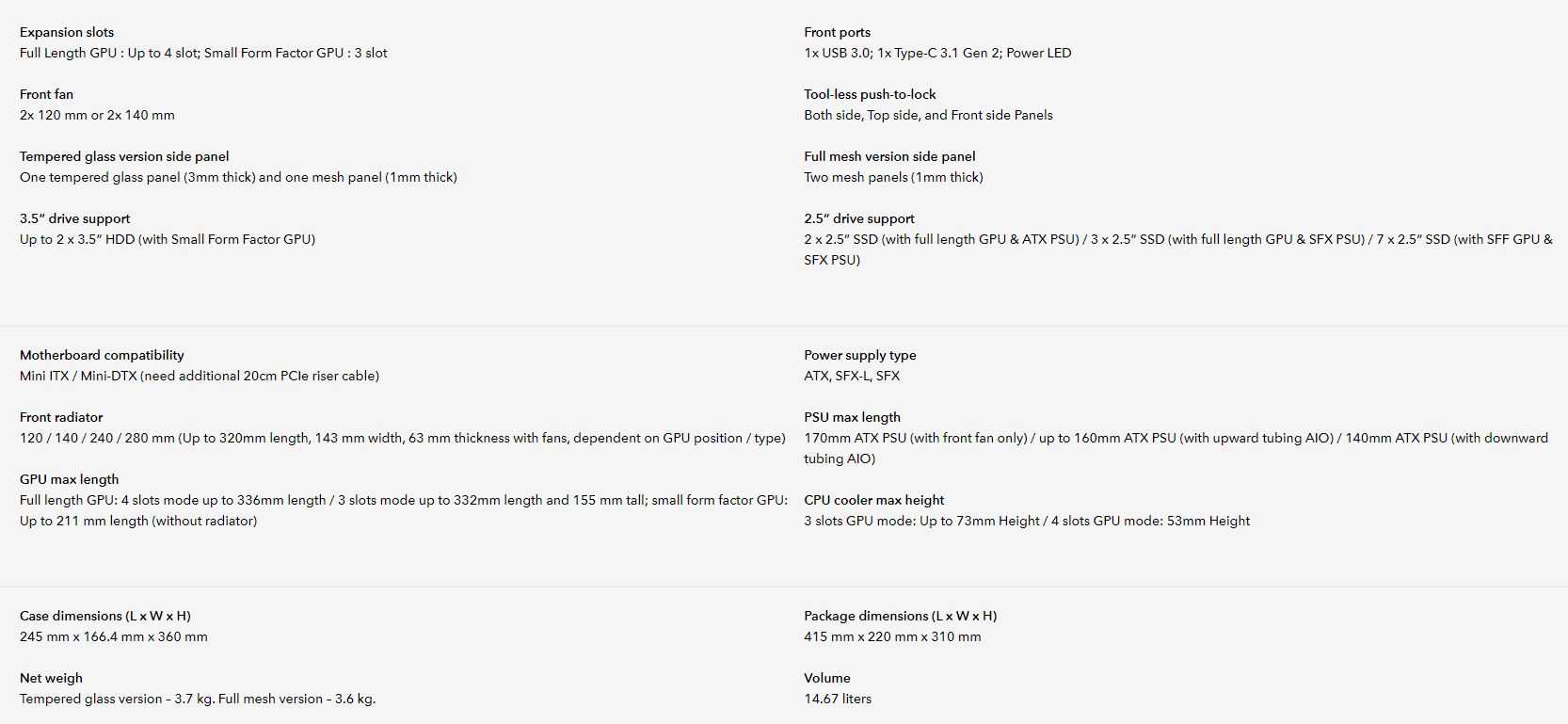
While studying the case for our SSUPD Meshlicious Mini-ITX Case review, we learned a couple of things about it. For the case’s expansion slots, it has a full-length GPU of up to four slots. For its small form-factor GPU, it has three slots.
The case allows you to either use two 120mm or two 140mm front fans. This is good since you have options to use your preferred fans.
When it comes to its tempered glass, one is a 3mm-thick tempered glass panel. The other is a 1mm-thick mesh panel. In addition, it has a drive support of up to 2x 3.5” HDD with a small form-factor GPU.
Speaking of its front ports, the Meshlicious Mini-ITX Case has a USB 3.0 and Type-C 3.1 Gen2 port.
The case has a 2.5” drive support for two 2.5” SSDs with full-length GPU and ATX PSU. It can also go for three 2.5” SSDs with full-length GPU and SFX PSU. Or seven 2.5” SSD with SFF GPU and SFX PSU.
Dimensions of the SSUPD Meshlicious Mini-ITX Case
The Meshlicious Mini-ITX Case measures 245mm x 166.4mm x 360mm (L x W H). And, it has a net weight of 3.6kg and a volume of 14.67 litres.
Case Compatibility
The Meshlicious Mini-ITX Case is compatible with mini-ITX and mini-DTX motherboards. Though for the latter, it will require an extra 20cm PCIe riser cable.
It works well with a 120, 140, 240, and 280mm front radiator. This is up to 320 x 143 x 63mm (L x W x D) with fans.
The GPU’s maximum length for four slots is up to 336mm in length. Or, its three slots for up to 332mm in length and 155m in height. For a small form-factor GPU, it’s up to 211mm in length without the radiator.
See also
Power supply type for the Meshlicious Mini-ITX Case is an ATX, SFX-L, SFX type. The PSU’s maximum length is 170mm ATX PSU with the front fan only. It’s also up to 160mm ATX PSU with upward tubing AIO, and 140mm ATX PSU with downward tubing AIO.
The maximum height of the CPU cooler with three slots GPU mode is up to 73mm tall. For four slots in GPU mode, its height is 53mm tall.
Лучший корпус Mini-ITX класса High-End
BitFenix Portal (около 10 000 рублей)
Корпус BitFenix Prodigy формата ITX быстро стал одним из самых продаваемых, благодаря своему уникальному дизайну. С выпуском компактного BitFenix Portal экспансия производителя продолжилась. Нетрудно догадаться, что при создании этого корпуса инженеры черпали вдохновение из одноименной видеоигры Portal, выпущенной компанией Valve. Получилось стильно.
Небольшие размеры корпуса (247x395x411 мм) диктуют использование здесь блоков питания SFX и вряд ли подойдут для комплектующих с массивными радиаторами. Зато корпус прост в эксплуатации и не займет много места, куда бы вы его ни поставили. Конструкция BitFenix Portal напоминает принцип выдвижного ящика стола. Чтобы получить доступ к внутренностям, достаточно выдвинуть из корпуса лоток с внутренним каркасом, на который устанавливаются комплектующие.
Тем пользователям, которым необходима высокая производительность (например, для видеоигр), придется отказаться от системы жидкостного охлаждения, либо установить компактную СВО Cooler Master MasterLiquid 240. Кроме того, в BitFenix Portal вполне уместится мощная видеокарта nVidia GTX 1080 или GTX 1080Ti, которая отлично потянет любую современную игру. Вентиляция в корпусе продумана хорошо, так что не стоит беспокоиться о перегревах.
SSUPD Meshlicious Mini-ITX Case Review – Design and Functionality
Now, our SSUPD Meshlicious Mini-ITX Case review will discuss the chassis’ functions and its design style. We’ll first talk about the case’s exterior.
Working with the Meshlicious Mini-ITX Case is fairly easy for this type of product. And it’s all thanks to the easy-to-remove panels on it. Every side of the case, save for its bottom section, are all made of mesh by default. One side is an exception since it’s made of tempered glass with a slight tint.
It has metal push pins to hold the sides, and these stay on firmly then pop off easily when needed.
Right out of the box, the Meshlicious Mini-ITX Case instantly showcases that SSUPD definitely knows how to build great products. The product is made from steel with perforated panels and a fine mesh made of 1mm holes. Interestingly, these holes also work as dust filters for the case.
In addition, its panels are sturdy and thick which gives the case a massive feel to it. So to put it simply, we had a great first impression with the Meshlicious Mini-ITX Case.
Now when you look at the front portion of the case, you’ll see its interior easily through the fine mesh. Also, you’ll notice that there aren’t any brandings on the visible panels. With that, system integrators will definitely delight in this case should they opt to build with it.
The only branding you’ll find is a slight emboss along the case’s rear.
From the top, the panel appears just like the one in front and the sides. That’s because SSUPD included a USB-C and USB 3.0 connector that you can use.
The bottom section of the case isn’t mesh since it’s part of the frame just like the rear.
There’s a cutout for access to its GPU display connectors that are routed via the hole along the rear. Looking closely, you’ll see a collection of simple mounting holes for the SSD, as well as two rubber-ringed mount holes.
When checking its interior, the front allows for mounting two 120 or 140mm fans, and a 240 or 280mm radiator. Along the side of the GPU, there isn’t much else by default.
The case that we have is bundled with the PCIe 4.0 riser cable. The company folded this to accommodate the long, vertical GPU setup.
Its internal layout sets the GPU on the left portion of the case. It is also where you’ll have a mesh panel of the same quality and style. On the CPU/PSU section, it sports a well-framed, clean, and clear glass side panel.
When taking a closer look at the rear, the bottom-half is made specifically for the PSU on the motherboard’s side. You can opt for any SFX-L, SFX, or even an ATX unit for this. To its left, you’ll see a little opening to route the GPU display cables that you’re using.
Above the opening, you’ll see three expansion slots on the GPU side and the standard board cutout to the right. It’s possible for you to shift the mounting frame in the centre to decrease the room on the board’s side. The space will be for a 4-slot GPU.
Plus, doing so will also mean that you have to utilise an SFX-L or SFX PSU.
Taking a closer look at the base of the GPU section, you’ll see cold blue spacers here. These function as the mounting ports for the vertically-mounted GPU.
The company lets you install a three-slot card without having to bother doing anything in the area. If you choose to go for a vertical mount for short GPUs, this is the spot. It is where you’ll install the frame the extra storage will link to.
Looking closely, you can see that the company lets you move the GPU mount brackets down or up. This is before providing you with a total of three mounting holes to use. It means, you have to move the PCIe riser cable’s position too.
Here, we utilised the top-most position to have adequate room for the display cables. These had the PCIe riser cables bump into the motherboard frame when we routed these through the opening. It was all due to the angled 45-degree corner cutout.
As we continued exploring the top for our SSUPD Meshlicious Mini-ITX Case review, we noticed another set of expansion slots. There were a total of three of these in place.
Along the PSU bay, you’ll see a mounting spot for the SSD on the frame. Specifically, it’s facing the PSU’s side.
This is the one you can’t utilise if you’re opting for a full-sized ATX PSU. Then at the top of that, everything else appears pretty classic along the motherboard’s mounting spot. It’s the area with the lengthy support beam that’s pre-installed right out of the box.
All cables in the Meshlicious Mini-ITX Case are sleeved back and are of the default kind. The notable difference is that one flat cable for the 3.0 connector. This is in line with the I/O that you’ll have access to.
Лучший корпус Mini-ITX класса High-End
BitFenix Portal (около 10 000 рублей)
Корпус BitFenix Prodigy формата ITX быстро стал одним из самых продаваемых, благодаря своему уникальному дизайну. С выпуском компактного BitFenix Portal экспансия производителя продолжилась. Нетрудно догадаться, что при создании этого корпуса инженеры черпали вдохновение из одноименной видеоигры Portal, выпущенной компанией Valve. Получилось стильно.
Небольшие размеры корпуса (247x395x411 мм) диктуют использование здесь блоков питания SFX и вряд ли подойдут для комплектующих с массивными радиаторами. Зато корпус прост в эксплуатации и не займет много места, куда бы вы его ни поставили. Конструкция BitFenix Portal напоминает принцип выдвижного ящика стола. Чтобы получить доступ к внутренностям, достаточно выдвинуть из корпуса лоток с внутренним каркасом, на который устанавливаются комплектующие.
Тем пользователям, которым необходима высокая производительность (например, для видеоигр), придется отказаться от системы жидкостного охлаждения, либо установить компактную СВО Cooler Master MasterLiquid 240. Кроме того, в BitFenix Portal вполне уместится мощная видеокарта nVidia GTX 1080 или GTX 1080Ti, которая отлично потянет любую современную игру. Вентиляция в корпусе продумана хорошо, так что не стоит беспокоиться о перегревах.
SSUPD Meshlicious Mini-ITX Case Review Summary
We were impressed with the Meshlicious Mini-ITX case. Despite the size, it’s a highly versatile chassis that allows for easy building. Also, its excellent design gives it less limitations unlike similar cases on the market.
What makes this case unique is its full-mesh design. It functions as a dust filter while providing more airflow for the components to stay cool.
With its sturdy engineering and flexible layout, the Meshlicious Mini-ITX Case isn’t just another case on the market. It sets the bar for mini-ITX cases, making it easy to recommend. The case is an excellent choice for those who want a small build without sacrificing performance.
Now that you’ve read our review, do you want this case for your small PC build? To get the SSUPD Meshlicious Mini-ITX Case, it’s available for purchase from the company’s official website.

